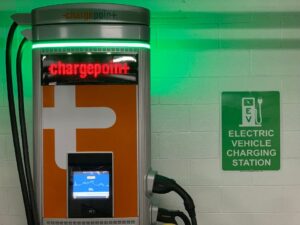

The landmark building—located just a few blocks from the White House, at the intersection of Constitution Avenue and 17th Street— first opened its doors in 1910 as the home of the Pan American Union, the precursor to the OAS. It has hosted momentous events in the history of the Western Hemisphere, including the 1977 signing of the Panama Canal Treaty.
Inside, the Hall of the Americas retains the grandeur of its era, but with a twist. The crystal chandeliers that have looked down on countless conferences, concerts, and visits by presidents and prime ministers are powered with LED lights. This is just one small example of steps the OAS has already taken to put sustainability into practice.
Now it is stepping up such efforts, increasing its use of renewable energy and putting a premium on efficiency. For an institution that depends on country dues and has long had budgetary struggles, the “driving force” behind these efforts is the need to save money, according to Enrique Bello, acting Director of the Department of General Services (DGS).
“If in the process we do it the green way,” he added, “even better.”
More than 700 staff, contract employees, and interns work at OAS headquarters. The physical plant consists of five buildings: four in the historic main complex (the House of the Americas, a large administrative building, the Museum of the Americas, and a small office building known as the Casita), in addition to the primary office location a few blocks away (the General Secretariat Building).
While the OAS has implemented some incremental changes over the past decade toward sustainability—for example, putting in more efficient sinks and toilets, cutting weekend energy use, and promoting recycling—some of the changes currently in the works are on a larger scale.
That is possible in part because today’s energy market provides creative solutions for financing renewable energy and energy efficiency projects, according to Bello, who worked in the OAS Department of Sustainable Development for more than two decades before starting his current job as DGS Director at the beginning of 2017. In some cases, for example, an energy service company will bear the up-front costs of installation and have clients pay back the costs over time, as a percentage of what they save on energy costs.
 At the General Secretariat Building, which opened in 1976, the OAS is preparing to install rooftop solar panels, but first it had to replace the aging roof—a project that had been put off for years for budgetary reasons. As part of an agreement signed with the OAS, a local solar company is covering not only the cost of installing the solar panels but even part of the cost of replacing the roof. (The solar company, for its part, will benefit from local tax credits.)
At the General Secretariat Building, which opened in 1976, the OAS is preparing to install rooftop solar panels, but first it had to replace the aging roof—a project that had been put off for years for budgetary reasons. As part of an agreement signed with the OAS, a local solar company is covering not only the cost of installing the solar panels but even part of the cost of replacing the roof. (The solar company, for its part, will benefit from local tax credits.)
Work on the roof has been completed, and the installation of the photovoltaic solar panels is expected to begin once pending local permits have been issued. The panels will supply about 10 percent of the building’s electricity needs at no cost to the OAS.
“As long as what we do promotes sustainability and environmental management, and generates savings for the Organization, I think it’s a win-win situation for everybody,” Bello said in an interview.
Here are just a few of the other areas where the Department of General Services of the OAS is working to cut costs and implement greener practices:
While facilities management is an important element in promoting energy efficiency and environmental sustainability, it is not the only one, Bello noted. These issues should factor into people’s everyday decisions and activities, he added—whether they are ordering supplies, planning meetings, making travel plans, or even getting to work every day.
“We could do much more as individuals and as an institution to reduce our carbon footprint,” Bello said. “It’s a matter of adopting a sustainable mindset.”
 View Map
View Map